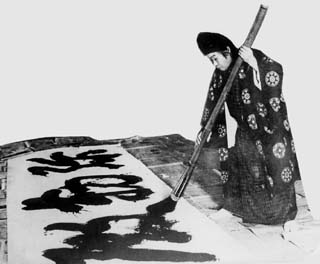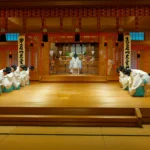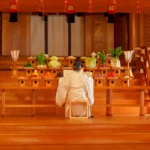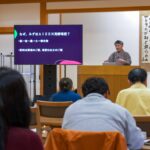By Ruth Reiner
As I mentioned in the last item, Oomoto will be entering another so-called “Golden age” at this time time that we are dealing with. Onisaburo survived the death sentence, and came back to the land of the rising sun, where the sun did actually rise for him the next day… Such an age for Oomoto a “Golden Age” (from the mid 1920’s, and through the decade following), of course reflects also on our one and only…

Onisaburo is now in his 50’s. Upon his return from the wide plains of Mongolia, he engaged himself in things such as reconstruction of the Oomoto headquarters, accepting guests, performing healing sessions, and of course never abandoning the arts! One of the most fantastic arts of this period in Onisaburo’s life (in my opinion), is his enormous calligraphies. they are definitely impressive (as an under-statement), and if any of you happen to come to Oomoto in the future I suggest you ask if those are on exhibit at the time!
(In the photograph in this item you can see the immensity of these outstanding works of art…)
Onisaburo had his way with people, I guess like any spiritual leader has in his or her special way. Just with Onisaburo sometimes it seemed like really, he did what impulsively he felt like without calling on the opinions that people would have about him. In Hebrew we have a saying: “He has no god!”, funny to use it for such a religious being, but this sentence just comes up in my mind the more I read about him… This expression means to me: he does as his heart desires!
You might remember that on the introductory item I mentioned the ‘Universal Love and Brotherhood Association’, founded by Onisaburo in 1925. This was too an enormous leap forward making this period in Oomoto’s history so ‘golden’. Onisaburo ordered headquarters to be established in Europe, the Far East, America. The principles were bringing friendship and harmony to the whole human race. Soon institutions such as the “Aizen Hall”, “Aizen Club”, “Aizen Clinic”, and others sprang up in various countries.
I always find it encouraging to hear of such organizations springing up in our world full of fear, hate and aggression. As a graduate of the International Relations department of the Hebrew University in Jerusalem, may I just mention on this strange stage, how I love N.G.O’s!
(Sorry a bit emotional there!) It was also a golden age for Oomoto in terms of the worldwide publications, that appeared in untraceable numbers.
To tell you the truth I hope you are still there with me. But you know, reading this book is like talking about life, sometimes: “No news is good news!” (A concept that I definitely adopt as an Israeli…). What I am actually getting at is that this item is not as juicy as the others I guess.
In this period, and we are talking about Onisaburo as a middle aged man, he also went into a “mass production” period in a wide range of arts, including movies, plays, poetry and calligraphy.
Actually one of the things that captured quite few people’s hearts (from my experience here) was when these people, (mostly people of western monotheistic concepts), entered the Oomoto sanctuary in Kameoka, and found the Noh theater stage inside the shrine. (This is quite rare also in Japan), I think this is a beautiful thing, and what I am getting at here is that art is for, me as well, a way to connect with the divine.
In chapter 33, we also find a sub chapter dealing with Onisaburo’s “spiritual state”. Here are mentioned things such as Onisaburos’ prophetic, spiritual dreams:
“For example, he had dreams in which he saw eight moons and seven suns in the sky, or dreams of crossing wide rivers. The former refers to the seventh of August, and the latter suggests that he would be able to come through some kind of difficulty safely.”
Onisaburo had many and various dreams, and later recounted that:
“Every night while I was in the house of detention, god showed me dreams. I longed for night to come so I could sleep, as it was my only solace. I counted the dreams I had in prison, and altogether they came to 3,552.” (ch 33)
It is also said that he had the ability to hear someone is thinking without the person ever opening his mouth. Another ability of his is presented also here in chapter 33:
“When a sick acquaintance became a subject of conversation, he might say (“he”, refers to Onisaburo), There is no hope for him.” When asked what he meant, he would reply, “I can smell death”.
As mention here in the book, he not only had a spiritual eye or third eye, but also a “third ear” or “spiritual ear”, and nose. I personally liked this analogy.
So anyway, you know we are now in somewhat of a change of seasons, both here in Japan, and in our story, cause I promise you “these are the last beautiful days before the winter wind starts blowing in…



